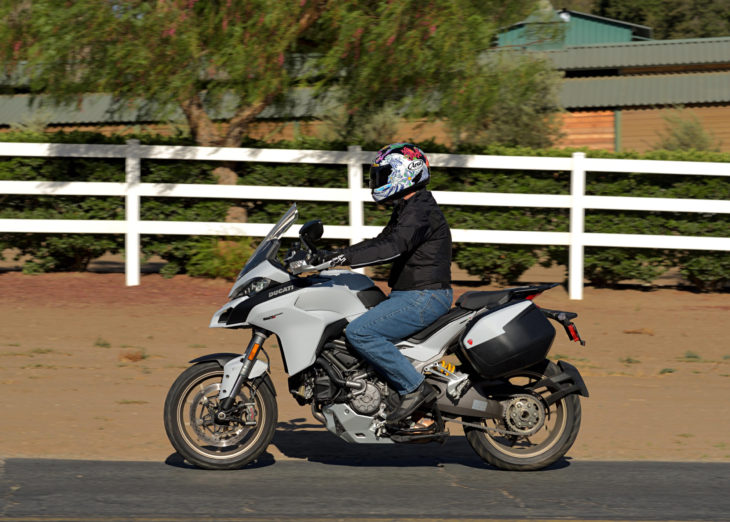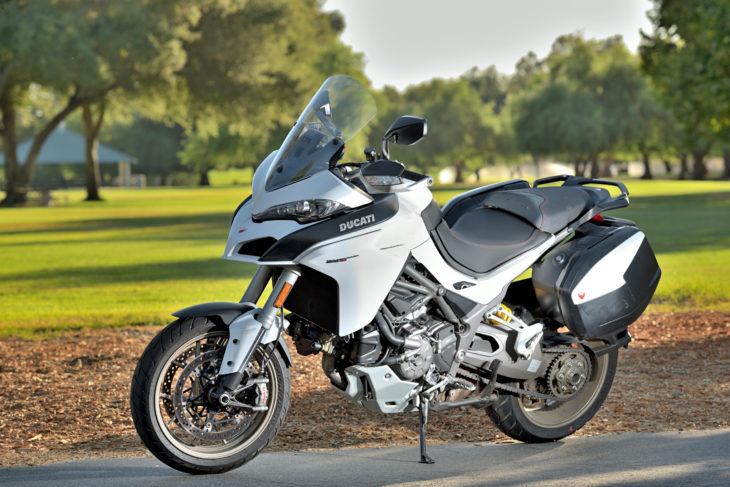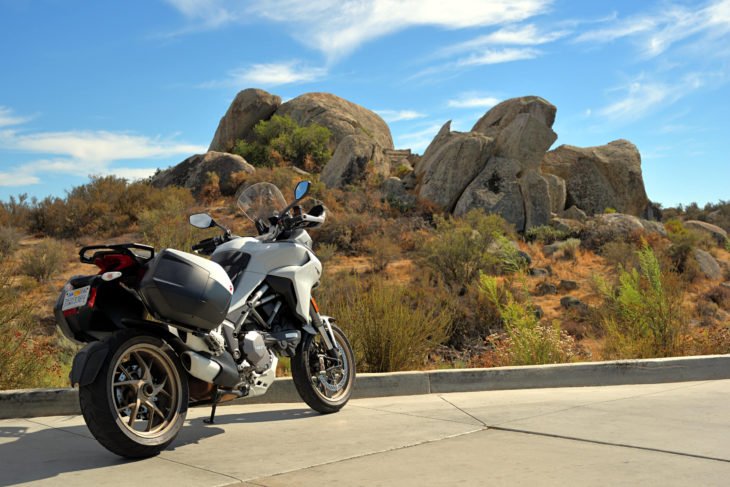
Everyone seems well aware that Ducati is no longer just a sport bike manufacturer. Although sport bikes are the principal element in Ducati’s history, and it still performs superbly on the international roadracing circuit, including MotoGP and WSB, the parts of its business generating the most buzz, of late, have nothing to do with sport bikes.
We’ve written extensively about the success of its new Scrambler sub-brand, but Ducati has also led the way, to some extent, when it comes to adventure touring models. Namely, the Multistrada line has evolved over more than a decade into a mature, well respected group of adventure models. You have two displacements to choose from, dirt-capable bikes like the just announced 1260 Enduro, as well as bikes like the 1260 S that is the subject of this test, which give you the comfortable, upright ergos of an adventure machine while largely abandoning any pretense of any off-road capability.
The 2018 Multistrada 1260 S that we tested is the first iteration of the Multistrada to feature the big 1,262cc v-twin originally developed for the XDiavel. Featuring the DVT system designed to spread torque and power across a broader rpm range, it represents a significant step up from the 1,198cc engine it replaces.
For 2018, the Multistrada 1260 line also receives significant chassis modifications … designed to create more “stable” handling. Between a longer swingarm and a more relaxed steering head angle, these bikes added 2.2″ to their wheelbase. Apparently, there was a concern that the “flickable” nature of the older chassis was a bit much, and that the nature of the big Multistrada was better matched by slower, more stable steering.
As you might expect from a flagship Ducati model retailing for more than $20,000, an impressive suite of electronic aids is present on the 1260 S. Get ready, because here is the list … Vehicle Hold Control (VHC), Riding Mode, Power Mode, Ducati Safety Pack (Cornering ABS Bosch + DTC), Ducati Skyhook Suspension (DSS) Evo, Ducati Wheelie Control (DWC), Ducati Quick Shift (DQS) up/down, Cruise control, Backlit handlebar controls, Ducati Multimedia System (DMS), colour TFT display, Full LED light, Ducati Cornering Lights, Automatic indicator switch off, and Anti-theft ready.
The dash is a gorgeous and bright, contrasty TFT screen with new software for more intuitive navigation of the options controllable by the rider from handlebar switches and rockers. The number of things the rider can adjust, individually, is almost mind-boggling. Essentially, each of the electronic aids, as well as suspension damping characteristics, can be fine tuned. At the same time, you can select a riding mode and the bike will default to certain settings Ducati considers appropriate for that mode.
Our “Touring” version of the Multistrada 1260 S included the standard luggage and a center stand, and we sampled both of the available seat heights (the standard position is the lower of the two). In addition to the electronically adjustable suspension, our test unit also featured, as all 1260 models do, excellent, radial-mounted, four-piston Brembo brake calipers squeezing two, large diameter discs in front. In sum, this upright, comfortable machine with luggage has all of the features found on a modern superbike, including the big, powerful engine.
This is a big bike, and, particularly with the bags installed, requires some flexibility to lift your leg up and over. With the 5.3 gallon fuel tank full, Ducati claims a curb weight of 518 pounds — reasonable for a large displacement adventure tourer, and lighter than most competitive models. The rider sits almost bolt upright with an easy reach to the wide bars, and reasonable leg room — although, with the shorter seat installed, perhaps a bit less than typically found in this category.
The standard seat height took some getting used to. Although padding and support are excellent, the shape of the seat seemed to push the rider forward into the tank somewhat uncomfortably. We tried the optional, taller position (you need to install a couple of rails to raise the seat), and the problem was solved. We found the shape and the height of the optional seating position (which seems to take away the tilt forward) preferable and very comfortable on extended trips.
Clutch action is reasonably light considering the big, powerful v-twin, and the engine is very flexible. Power comes on at very low rpm levels in a smooth and predictable manner. Delivery is so linear that you might not realize how quick the 1260 S really is.
We got on well with the transmission, and don’t recall any missed shifts during our testing. The six gear ratios are plenty broad, given the relatively flat torque curve, such that one, two, or even three gears are frequently available to do the job at hand. RPMs are low at highway speeds in sixth gear, but the generous torque still allows passing maneuvers without a downshift.
Wind protection is quite good from the hand guards and adjustable windscreen (the adjustment can be accomplished without tools by squeezing a lever just above the dash). Luggage capacity offered by the two side bags is reasonably generous (they are fairly deep) and their operation is straightforward (including the ability to lock the bags). Removing them is relatively simple, as well.
Handling is solid and predictable, and noticeably lazier than older Multistrada models thanks to the substantially increased wheelbase and relaxed steering geometry. This is a trade-off for the increased stability sought by Ducati. This will please some owners, and frustrate some others, but we think Ducati struck a good balance here. You can still hustle the Multistrada 1260 through curvy roads at near sport bike speeds, and the bike is more composed.
The brakes offered good feel with less initial bite than found on Ducati’s sportier models, although the power is there if you keep squeezing. The self-cancelling turn signals are a nice feature that you quickly take for granted.
Ducati’s quick-shifter allows full throttle up-shifts, as well as aggressive down-shifts that are automatically rev matched. Pretty slick, although it seems to work best, in both directions, with the revs up above 5,000 rpm. Kicking a down-shift, for example, at lower rpms seems a bit clunky, and the bike resists the effort at times. You can always use the clutch, of course.
We generally left the bike in “Touring” mode, which offers full power and a reasonable throttle response. It also chooses default suspension settings that work well for commuting and relaxed riding. The more aggressive Sport setting will automatically choose stiffer damping characteristics that work better for spirited canyon carving. As stated earlier, within any throttle map, you can fine tune suspension damping characteristics, combining the Touring mode with very stiff suspension settings, for example. If you wish, you can also play with the individual settings for ABS, traction control, wheelie control, etc.
During our test, we noted mileage in the mid-40s mpg, which can vary considerably depending on the riding mode you choose and how hard you twist the right grip. More relaxed riding modes, including Urban and Low Power, mellow things out considerably, but also return better fuel economy.
An available Ducati Link App allows riders to adjust settings from their phone, as well as engage with social media to share riding info, etc. We confirmed that the app works on an iOS device, but we didn’t play with it much.
The 2018 Ducati Multistrada 1260 S has come a long way from the original Multistrada models offered by Ducati. It is a thoroughly comfortable machine with huge power. The bags and the wind protection make it a practical tourer/commuter that can still show you a good time on twisty roads. Beneath it all you have the 90° v-twin beating away with the typical Ducati character and feel.
This is a lot of motorcycle, and it will cost you a lot of green. The Standard Multistrada 1260 starts at $18,695. Our 1260 S, before some of the options on our test bike, starts at $20,995. The 1260 S is available in Iceberg White (the color of our test unit), Volcano Grey and Ducati Red. Take a look at Ducati’s web site for additional details and specifications.
See more of MD’s great photography:












The proper way to mount and dismount these monsters, especially with the sidecases in place, is to step up onto them via the footpeg. Left foot on the peg then step up and swing the right leg over.
Anything other than top opening aluminum side cases makes little sense either.
I bought one, had it since Easter. I also have a 10 year old RC8, itself a versatile sports V-twin and the two are comparable but the multi-strada does what it says on the tin: it works well on all roads. It isn’t as knackering on long motorway hauls as the RC8 yet works well on the narrow twisty’s when you get there. The frame, geometry and suspension are carefully designed to make this possible, that’s reflected in the price.
It’s far more powerful at every level them my RC8 and rather renders it redundant in that department. I’ve been down to the Pyrenees, followed some of the TdF on mountain roads, down to the beaches of Spain and up to the single track roads of the North-West Highlands of Scotland. This bike did it all and was well suited to all those roads and distances.
I considered a full dress tourer, tested a Gold Wing but glad I bought the multi. I think it takes two years to really bond with a bike and get to know it intimately so I’ll keep it one more year but if Moto-Guzzi finally make a proper tourer I’ll buy that or else a big US tourer – subject to sanctions!
But does it have a functioning rear brake???? I have a 2010 and it is a fantastic bike BUT the rear brake is a common and known weak spot that Ducati really did nothing about for quite some time (I’ve heard the new ones were ok, but not great). Despite claiming “more power” in every upgrade since 2010, the bike seems to have the same hp as the original 1200. I am also surprised by the lack or torque comments by the readers, because I find it to have an abundance (my other rides are a Superduke and an Africa Twin). Anyway I see no reason for the extra length, and although I would love cruise control and a functioning rear brake I cannot justify the cost of new. But if a nice low mileage garage queen of last years variety came along….
What do you need need the rear brake for? Seemed to hold quite well for hill starts on the Multis I have ridden.
Rear brake is really useful when offroading.
How about a shootout between the Multistrada, the Super Adventure S and the 1250 GS? That’d be killer.
Or… How about the Multistrada 1260 Pikes Peak vs the KTM SuperDuke GT?
……
I’m not headed off road and the taller stance takes away from street handling.
I would really like to test ride one, But I think I would be more toward their adventure version.
If they wanted to slow the steering they could have put a 19″ front wheel – would have helped with the proportions.
This is a great performing ugly bike! At least they got it half right.
For an adventure tourer, I think this is a very attractive bike, especially in red. But as Frank said, “Form follows function,” and this bike has a lot of function. I have never owned a Multistrada, but I rented a 1200 overseas for a couple of weeks. I really liked it, except for the lack of low end torque. The 1260 seems to solve this problem. True it is not for everyone, but it really is quite a complete bike for sport/adventure touring. I am always amused when people on this site slam bikes then have only seen online. Try it, you may like it.
Dude, it’s hideous.
Cool chopper.
Nah. Not a very nice looking bike. Too much electronics bumping the price into the stratosphere. Nothing flows about it. Looks like a magnet just scooped up all these random parts. Fun to ride I am sure. My brother has an 07. But us mere mortals can’t afford these tricked out machines.
More bike than I need, thank you, but I love the Multistrada. A comfortable bike if you fit it, and a hooning hooligan if you trust it.
Volcano Grey ? Looks like clear coated primer to me.
Boring.
it’s a little understated, it would look better with a few red accents here and there, it’s ok though and would be my pick by default cuz the other two suck. On the new guzzi i hate the grey for some reason, the wacky bright one looks much better
I’ve been hoping for a modern Ducati street single since the 90s Supermono. Still not entirely sure why they haven’t developed one – especially now when it would be a great fit in the Scrambler brand.
Singles aren’t well suited to conditions found in the US; twins typically just do the job better.
From the side the front looks like a bird with its mouth open trying to eat the front wheel :).
You mean it isn’t?
Dang it! Now I can’t un-see the bird’s mouth trying to eat the front tire. Oh well, I couldn’t afford the bike anyway………..
Bird’s mouth trying to eat the front wheel….
Just try NOT to see it, having seen it.
The SuperDuke GT looks better and better
If Ducati made a 450 street single with NO gadgets and less than 400 pounds, would it still cost a multiple of $5000 ?
Reginald,
Why not just buy a KTM Duke 390 for about $6000 brand new. Yes it’s closer to a Monster than a Multistrada but without the Italian accent.
See Royal Enfield Himalayan. Well under one multiple of $5000.
Shopping in the wrong aisle. Not Ducati’s wheelhouse. Their “value” bike is the Scrambler.
FWIW, this monster only weighs 518lb, very light for what it is.